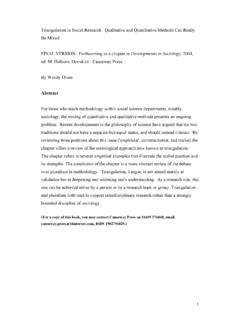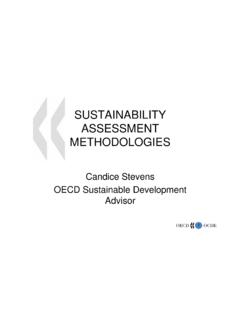Transcription of Mixing and Matching: Using Qualitative Methods to Improve ...
1 Mixing and Matching: Using Qualitative Metho ds to Impro ve quantitative Impact Evaluatio ns (IEs) and Systematic Reviews (SRs) o f Develo pment Outco mes Emmanuel Jimenez 1, Hugh Waddington1,Neeta Goel1, Audrey Prost2, Andrew Pullin3, Howard White4, Shaon Lahiri1 and Anmol Narain1 with the assistance of Raag Bhatia1 Paper Title Author1, Second Author2, Third Author3 1 International Initiative for Impact Evaluation 2 London School of Hygiene and Tropical Medicine 3 Bangor University 4 Campbell Collaboration 1 First Author Affiliation 2 Second Author Affiliation 3 Third Author Affiliation Suggested Citation.
2 Jimenez E, Waddington H, Goel N, Prost A, Pullin A, White H, Lahiri S, Narain A, Bhatia R, 2018 Mixing and Matching: Using Qualitative Methods to Improve quantitative Impact Evaluations (IEs) and Systematic Reviews (SRs) of Development Outcomes CEDIL Inception Paper 5: London About CEDIL: The Centre of Excellence for Development Impact and Learning (CEDIL) is an academic consortium supported by UKAID through DFID. The mission of the centre is to develop and promote new impact evaluation Methods in international development. Corresponding Author: Dr Emmanuel (Manny) Jimenez Copyright: 2018 This is an open-access article distributed under the terms of the Creative Commons Attribution License, which permits unrestricted use, distribution, and reproduction in any medium, provided the original author and source are credited.
3 Table o f Co ntents Abstract 1 Section 1 Executive Summary 2 Section 2 Introduction 5 Section 3 PART ONE: IMPACT EVALUATIONS 7 Section 4 PART TWO: SYSTEMATIC REVIEWS 28 Section 5 PART THREE: CONCLUDING REMARKS AND RECOMMENDATIONS 38 References 44 1 Abstract Recent books about evaluations to study the quantitative impact of development programs and projects typically devote a chapter or two of the need to complement the analysis with other Methods specifically Qualitative techniques. They often cite how Qualitative techniques help explain the reason for positive or negative quantitative results.
4 This is key if the one is to draw conclusions for accountability or for learning to Improve future program design. Or they explain how Qualitative work is critical to make sure that quantitative data are collected in the right way. Despite these textbook recommendations, there has been a wide range of experiences in how Using both quantitative and Qualitative Methods have affected the overall quality of evaluations. In many cases, the Qualitative analysis consists mostly of quotes to justify findings from the quantitative work. While this helps provide context, there is not much value-added beyond making an otherwise dry quantitative presentation more interesting.
5 Some recent evaluations have begun to change this practice and have arguably improved the quality of impact evaluations in terms their relevance, the inferences that are drawn from them and their applicability to policy makers and programme implementers. This includes the use of innovative techniques to form the specific evaluative questions being asked and tested, to gather the right type of data and information on outcomes and intermediating variables, to explain findings and to disseminate them to the appropriate decision-makers. This paper will review this work. It will canvass a purposeful sample of experts from a variety of disciplines to gather the success stories, and where apparently well-planned approaches have failed to add the value expected of them.
6 It will then draw lessons for future evaluations as a basis for guidance on use of mixed Methods . 2 Section 1 Executive Summary Recent evaluations have begun to use Qualitative data in a manner that arguably helps Improve the quality of these studies in terms of their relevance, the inferences that are drawn from them and their applicability to policy makers and programme implementers. These evaluations have used innovative techniques to form specific evaluative questions, to gather insight into the outcomes and intermediate variables, and to explain findings. This paper reviews this work and identifies good practices to integrate Qualitative Methods into quantitative impact evaluations (IEs) and systematic reviews (SRs).
7 Using recent literature on the characteristics of such practices, we developed two tools to assess the methodological rigour and mixed Methods integration of 40 IEs and 7 SRs, drawing upon previous approaches. The tools, while designed specifically for each type of study, are closely related because the evidence generated by IEs flow naturally into SRs. To capture a broad breadth of international development interventions while still making our task manageable, we assessed studies in seven sectors agriculture, climate change, education, financial inclusion, health, infrastructure and governance.
8 We drew upon systematic reviews and impact evaluation repositories in each of these sectors to identify mixed Methods impact evaluations (MMIEs) and mixed Methods systematic reviews (MMSRs). Our main findings are that quantitative impact evaluations that successfully integrated Qualitative Methods were those that: Were rigorous in applying each method. Studies that scored highly on quantitative and Qualitative rigour also tended to score highly on integration; Provided a clear rationale for the integration of Methods . The top scoring studies made clear the rationale for integration at key stages of the evaluation, and often noted the value-added of doing so; Deployed multidisciplinary teams: Given epistemological, ontological and methodological differences in quantitative and Qualitative Methods , multidisciplinary teams can offer a substantive treatment to mixed Methods and their synthesis.
9 However, successful integration should be based on a common premise behind ideas, concepts and evaluation approach; Provided adequate documentation: A common element among our exemplar studies is the provision of adequate documentation, be it within a report, or through supplementary reports and/or appendices; 3 Acknowledged limitations: Acknowledging the limits of integrating Qualitative and quantitative findings facilitates a better understanding of the transferability of findings, and their implications in the policy domain. Successful integration tended to Improve mixed Methods impact evaluations by: Collecting better data: At the level of data collection, integrating Qualitative and quantitative lines of enquiry lies in the use of different Methods of data collection, and how they inform study design and findings; Validating findings through integration: In several studies that score highly on integration, when Qualitative and quantitative findings diverged, the authors discussed the reasons and implications for the differences, which informed their reported interpretation of findings.
10 Contextualising quantitative results: In some cases, consolidating Qualitative data obtained by different Methods helped situate the findings in the local context. Mixed Methods impact evaluations can be especially useful in fragile and conflict-affected settings which pose a particular challenge in terms of data collection from individuals; Contributing to forming policy recommendations: Successful integrations can inform policy recommendations by making contextually relevant policy recommendations. All of the exemplar studies report how mixed Methods data influenced their policy recommendations.








